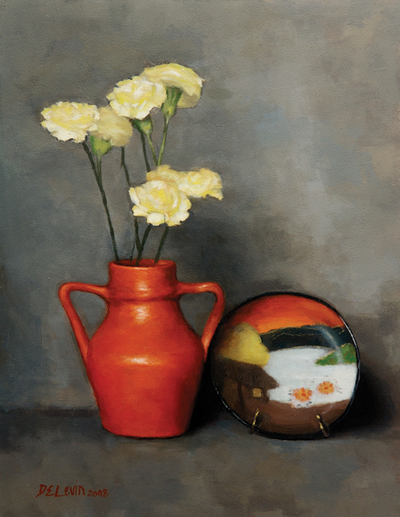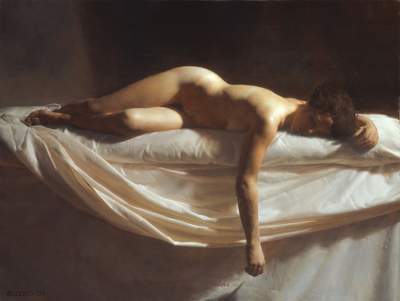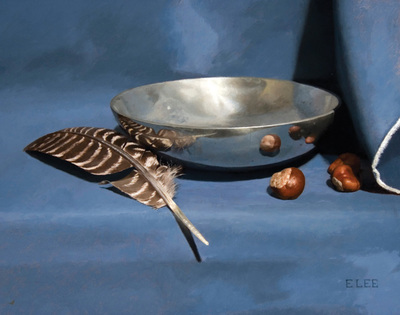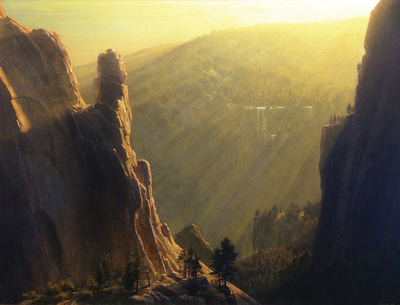The New Traditionalists in New England

Dana Levin, Carnations and Japanese Plate, 2008, oil on panel, 11 x 14″.
Emilie Lee of Burlington, VT, is a subversive. So is Joseph McGurl of Cape Cod. And so is Dana Levin of Reading, MA. All three paint people, objects and landscapes. Their canvases look like life, but only more so—as if they’re depicting a deeper reality. All three possess advanced skills in drawing and painting. At least one of this trio has received training overseas. They are part of a growing network, with cells across the Northeast. Meet the Classical Realists.
“Realism means representing the world as we see it, rather than through abstract or conceptual ideas,” said Lee. “The Classical part refers to a desire to reconnect with a tradition.” These are heretical thoughts in a painter. Novelists, filmmakers and photographers are allowed to be realists—but not serious artists. For more than a century, since the great modernist revolt, artists have advertised the unreality of their work and have often abandoned paint entirely. As for Classicism, that went out of fashion with the Impressionists.
When a revolution succeeds, it starts to die. Lee, McGurl and Levin all discovered that the avant-garde had decayed into institutional orthodoxy. With yesterday’s rebellion becoming today’s conformity, the old tradition becomes a kind of radical dissent. All three Classical Realists had to find their own teachers.
“I studied at the Massachusetts College of Art,” Joe McGurl recalled from his studio on Amrita Island, Cape Cod. “When I graduated, I realized I never had a strong drawing course.” For instruction, McGurl turned to the Realists of the Guild of Boston Artists.
Lee and Levin went further afield. Lee grew up in Vermont and took her first lessons from her mother, a Realist painter. “I went to the Rhode Island School of Design, which everyone told me was the best school you could go to. I had a really frustrating time. I told one of my professors that I wanted to draw like Rembrandt. He told me, ‘Sorry, nobody knows how to do that anymore, and I don’t know how to draw because I spent the seventies doing acid and throwing paint at the canvas.’ I left wanting nothing to do with the art world.” said Lee.
But she knew she had to keep painting. An expert rock climber, Lee hit the road in a converted school bus and lived in national parks while trying to emulate the Hudson River School. “I thought, I’m going to find a way to make art like I want to, in a way that feeds my spirit and that celebrates the beauty in the world,” she said. One day, she met Camille Korry, a painter in Salt Lake City. “Camille’s studio was like stepping back in time: Classical artworks, cast drawings, jars of pigment—she mixes her own paints. I knew immediately that this was what I was looking for.”
The next week, Lee moved to Salt Lake City. Six months of training with Korry brought her to the fork in the Classical Realist’s road: to study in Italy, where the American expat Daniel Graves founded the Florence Academy of Art in 1991; or in New York, at the Grand Central Academy with the doyen of Classical Realist painters, Jacob Collins?

Jacob Collins, Anna, 2004, oil on canvas, 36 x 48″.
Lee chose New York. “I studied for four years with Jacob and then taught at the Grand Central Academy for three more. It was really stimulating and challenging to be around all the amazing artists at the GCA. They’re so hungry for knowledge and are really pushing themselves to get better.” The audacious realism of Lee’s Ball Mason and Feather and Chestnuts evoke the masters of 19th-century American trompe l’oeil, William Harnett and John Peto.
Dana Levin took the other fork and went to Florence. After graduating from the Art Institute of Chicago, the Virginia-born Levin experimented on her own in a studio in San Francisco. Gradually, she drifted into realism. “It was a very natural process. I was drawing more from life, but then I realized that I didn’t know how to draw. I thought, I’ve been doing this my whole life, it’s all I’ve ever done. I’ve gone to school for this, and I can’t look at something and draw what’s in front of me!” said Levin.
A grant from San Francisco’s Italian Cultural Institute covered Levin’s first year in Florence. “And that’s how I became a Classical Realist.” She worked from morning to night, drawing from casts and the figure. “It was traditional: working in pencil, charcoal and oil paint,” said Levin. In her picture, Pink Rose 2, the petals are precise and naturalistic, but the rougher leaves remind us that we are looking at paint.
Like Lee, Levin remained in her school as a teacher, passing on her skills to a growing number of students, many of whom struggled with disillusionment at art school—only to discover that they were not alone.

Emilie Lee, Feather and Chestnuts, 2010, oil on linen, 14 x 12″.
“The term Classical Realism was invented by Richard Lack,” Jacob Collins explained. “In the fifties, Lack studied with a Boston School painter called R.H. Ives Gammell, who claimed a legitimate connection to the 19th-century French Academy through his studies at the Académie Julian in Paris. They were trying to make unapologetically traditional art. It was a heroic thing to do,” Collins said, “extremely unpopular with the smart set.
In 1969, Lack set up an atelier in Minneapolis to teach traditional drawing and painting. Nearly five decades later, Classical Realism is thriving, and Classical Realists are in major American museum collections. Collins, whose work sells for up to $125,000, is training a new generation in his New York atelier. Yet learning techniques is only the first step in the formation of a style. The challenges of Classical Realism are not just technical, but also philosophical and stylistic.
“In a way,” McGurl reflected, “Classical and Realism are opposite terms. Classical refers to an idealized world, and Realism refers to the world as we see it and experience it. These two opposites come together to form a genre that combines the two.” Every Classical Realist must reconcile these two elements to create a personal vision that is both within the tradition and also contemporary. Lee, Levin and McGurl all engage with earlier schools of Northeastern painting, such as the Hudson River painters and the Boston School, but each deploys strategies for keeping the tradition alive.
“The key to not becoming kitsch is to stay true to yourself,” Lee said. For her, this means immersion in Vermont’s natural beauty. “I go outside. I make drawings and quick paintings, and then I go back into the studio. That’s when the problem solving comes in, and when I start to look at my books. I wonder how Sanford Gifford or Frederic Church would have done it, or Andrew Wyeth, who’s not really a Classical Realist painter, but somebody I find really inspiring.”
McGurl also begins en plein air. A native New Englander, he admires the Transcendentalists’ reverence for nature. “I embraced that part of my cultural identity. When I’m out of doors, I try not to think about the paintings that I’ve seen. I look for something that’s fascinating in its own way and try to translate that as honestly as I can in the field.” He draws from nature and then transforms his raw material in the studio. “Most of my studio paintings are imaginary—things that I’ve witnessed are combined with inventions.”
McGurl shares the spiritual ambitions of the 19th-century Luminists, but not all of their techniques. “It’s more of a philosophical alignment. My paintings don’t have that smooth Luminist surface or that brownish tone.” The dusk in his Acadia, Sunset Light and Shade is crisp, and the sunlight in Light Streams, Yosemite is radiantly expressive. “I believe that there’s a spirituality in the natural world.”

Joseph McGurl, Light Streams, 2015, oil on canvas, 30 x 40″.
Levin takes a different approach. “I was in Florence for many years, working in a north-facing studio; the same kind of space and light as the Renaissance painters had used. When I came back to the States, I had a north-facing studio, but with higher, bigger windows. So the paintings looked different.” She also contends with differences of history and geography. “I grew up in Miami. My world was really plastic and modern. I can’t fight who I am. I could find a north-facing studio, but there would still be something about it that isn’t really from me and my time.” She modernized her practice, synthesizing her influences by bringing artificial light into her studio in Reading, MA.
“We live in a different time. These are our circumstances. I can move and control the artificial light, and make it do anything I want. I’m not only using the object to compose. I get to compose with the lights too.” The naturalistic shadows in her Carnations and Japanese Plate show that realism, though it begins in observation, relies upon artifice in execution. “If one corner of the painting needs more light, or if I need a shadow to create an effect, I can make that happen in a way that couldn’t have been done before.”
Dominic Green, PhD, is a historian and critic. He teaches politics at Boston College and writes regularly for the Wall Street Journal, the New Criterion, and the London Spectator.
